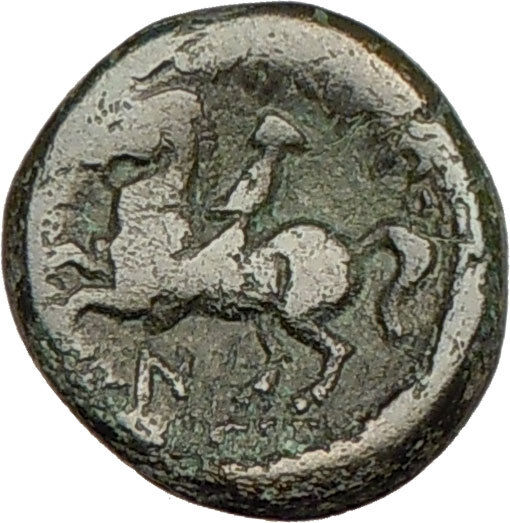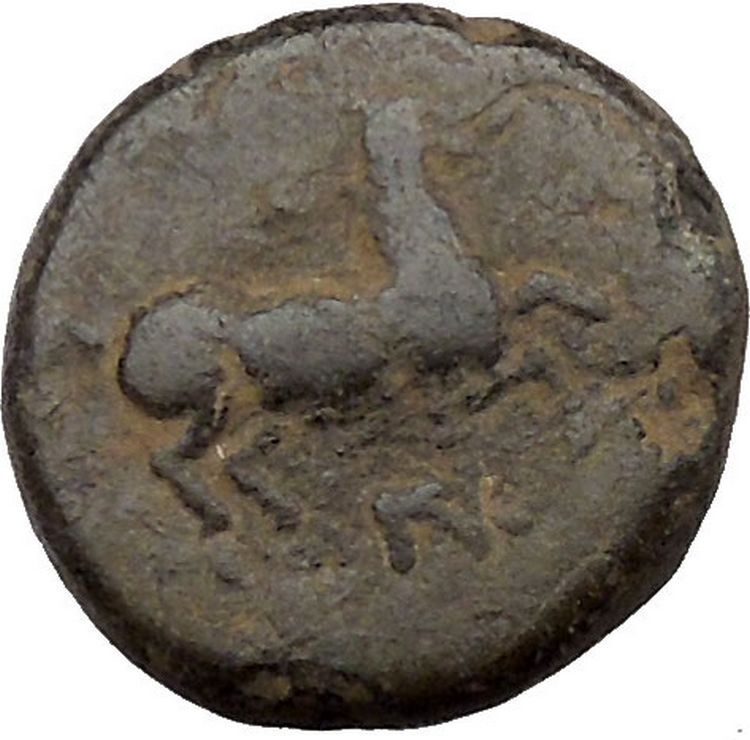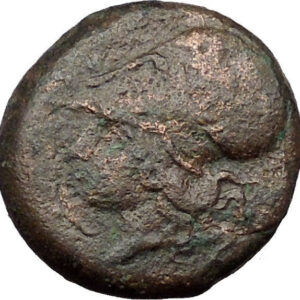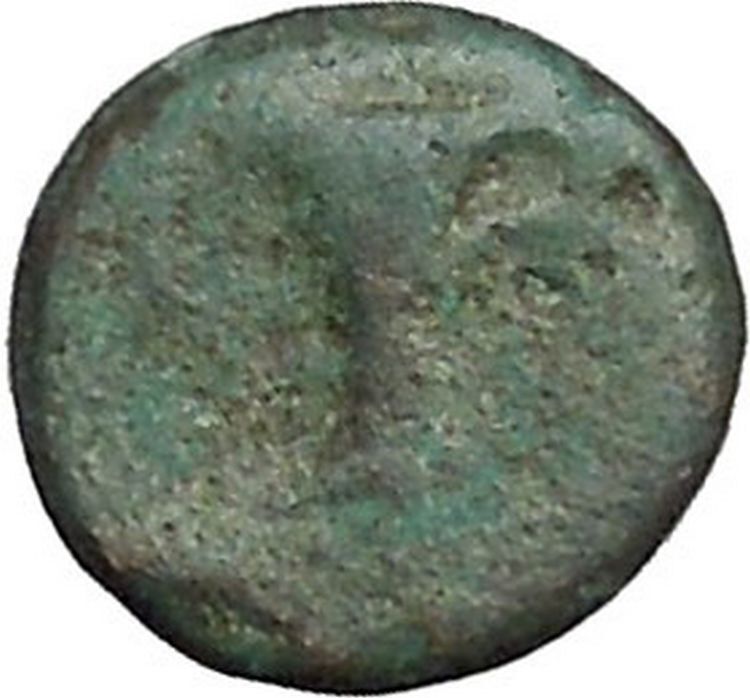|
Greek city of Kallatis in Moesia
Bronze 25mm (8.74 grams) Struck circa 3rd-2nd centuries B.C. Atha- Magistate
Reference: HGC 3.2, 1828 (Rare R1); SNG Stancomb 71
Certification: NGC Ancients Ch VF 4936009-011
Laureate head of Apollo right.
ΚΑΛΛΑ / ΤΙΑΝΩΝ either side of tripod-lebes; corn ear in outer left; magistrate’s name AΘA below.
Kallatis (Callatis), a town of Moesia, on the Black Sea, originally a colony of Miletos, and afterwards Heraklea Pontika.
You are bidding on the exact item pictured, provided with a Certificate of Authenticity and Lifetime Guarantee of Authenticity.
 In Greek and Roman mythology, Apollo, is one of the most important and diverse of the Olympian deities. The ideal of the kouros (a beardless youth), Apollo has been variously recognized as a god of light and the sun; truth and prophecy; archery; medicine and healing; music, poetry, and the arts; and more. Apollo is the son of Zeus and Leto, and has a twin sister, the chaste huntress Artemis. Apollo is known in Greek-influenced Etruscan mythology as Apulu. Apollo was worshiped in both ancient Greek and Roman religion, as well as in the modern Greco-Roman Neopaganism. In Greek and Roman mythology, Apollo, is one of the most important and diverse of the Olympian deities. The ideal of the kouros (a beardless youth), Apollo has been variously recognized as a god of light and the sun; truth and prophecy; archery; medicine and healing; music, poetry, and the arts; and more. Apollo is the son of Zeus and Leto, and has a twin sister, the chaste huntress Artemis. Apollo is known in Greek-influenced Etruscan mythology as Apulu. Apollo was worshiped in both ancient Greek and Roman religion, as well as in the modern Greco-Roman Neopaganism.
As the patron of Delphi (Pythian Apollo), Apollo was an oracular god – the prophetic deity of the Delphic Oracle. Medicine and healing were associated with Apollo, whether through the god himself or mediated through his son Asclepius, yet Apollo was also seen as a god who could bring ill-health and deadly plague as well as one who had the ability to cure. Amongst the god’s custodial charges, Apollo became associated with dominion over colonists, and as the patron defender of herds and flocks. As the leader of the Muses (Apollon Musagetes) and director of their choir, Apollo functioned as the patron god of music and poetry. Hermes created the lyre for him, and the instrument became a common attribute of Apollo. Hymns sung to Apollo were called paeans.
In Hellenistic times, especially during the third century BCE, as Apollo Helios he became identified among Greeks with Helios, god of the sun, and his sister Artemis similarly equated with Selene, goddess of the moon. In Latin texts, on the other hand, Joseph Fontenrose declared himself unable to find any conflation of Apollo with Sol among the Augustan poets of the first century, not even in the conjurations of Aeneas and Latinus in Aeneid XII (161-215). Apollo and Helios/Sol remained separate beings in literary and mythological texts until the third century CE.
 A sacrificial tripod is a three-legged piece of religious furniture used for offerings or other ritual procedures. As a seat or stand, the tripod is the most stable furniture construction for uneven ground, hence its use is universal and ancient. It is particularly associated with Apollo and the Delphic oracle in ancient Greece, and the word “tripod” comes from the Greek meaning “three-footed”. A sacrificial tripod is a three-legged piece of religious furniture used for offerings or other ritual procedures. As a seat or stand, the tripod is the most stable furniture construction for uneven ground, hence its use is universal and ancient. It is particularly associated with Apollo and the Delphic oracle in ancient Greece, and the word “tripod” comes from the Greek meaning “three-footed”.
The most famous tripod of ancient Greece was the Delphic Tripod from which the Pythian priestess took her seat to deliver the oracles of the deity. The seat was formed by a circular slab on the top of the tripod, on which a branch of laurel was deposited when it was unoccupied by the priestess. In this sense, by classical times the tripod was sacred to Apollo. According to the myth, Hercules went to the oracle of Delphi in order to ask what to do in order to be expiated from the murder of Iphitos. The oracle did not want to give him an omen. Then, the hero was enraged and he grabbed the tripod on which the Pythia sat in order to pronounce her oracles. Apollo tried to prevent him and this resulted in a fight between the god and the hero. Finally, Zeus had to intervene in order to end this quarrel.The mytheme of Heracles contesting with Apollo for the tripod appears in vase-paintings older than the oldest written literature. The oracle originally may have been related to the primal deity, the Earth. In the Geometric period, the tripods were fastened to the cauldrons they supported. In the Museum of Delphi there are fragments of such tripods, most distinctive of which is the one with a ring-shaped handle.
Another well-known tripod in Delphi was the Plataean Tripod; it was made from a tenth part of the spoils taken from the Persian army after the Battle of Plataea. This consisted of a golden basin, supported by a bronze serpent with three heads (or three serpents intertwined), with a list of the states that had taken part in the war inscribed on the coils of the serpent. The golden bowl was carried off by the Phocians during the Third Sacred War (356-346 BC); the stand was removed by the emperor Constantine to Constantinople in 324, where in modern Istanbul it still can be seen in the hippodrome, the Atmeydanı, although in damaged condition: the heads of the serpents have disappeared, however one is now on display at the nearby Istanbul Archaeology Museums. The inscription, however, has been restored almost entirely. Such tripods usually had three ears (rings which served as handles) and frequently had a central upright as support in addition to the three legs.
Tripods frequently are mentioned by Homer as prizes in athletic games and as complimentary gifts; in later times, highly decorated and bearing inscriptions, they served the same purpose. They appear also to be precious gifts for the guests, as in the case of the Phaeakes, who offered a cauldron and tripod to Odysseus. Our guest has already packed up the clothes, wrought gold, and other valuables which you have brought for his acceptance; let us now, therefore, present him further, each one of us, with a large tripod and a cauldron. We will recoup ourselves by the levy of a general rate; for private individuals cannot be expected to bear the burden of such a handsome present. Odyssey, 13.10-15 [tr. S. Butler] They also were used as dedicatory offerings to the deities, and in the dramatic contests at the Dionysia the victorious choregus (a wealthy citizen who bore the expense of equipping and training the chorus) received a crown and a tripod. He would either dedicate the tripod to some deity or set it upon the top of a marble structure erected in the form of a small circular temple in a street in Athens, called the street of tripods, from the large number of memorials of this kind. One of these, the Choragic Monument of Lysicrates, erected by him to commemorate his victory in a dramatic contest in 335 BC, still stands. The form of the victory tripod, now missing from the top of the Lysicrates monument, has been rendered variously by scholars since the 18th century.
Martin L. West writes that the Pythia at Delphi shows many traits of shamanistic practices, likely inherited or influenced from Central Asian practices. He cites her sitting in a cauldron on a tripod, while making her prophecies, her being in an ecstatic trance state, similar to shamans, and her utterings, unintelligible.
According to Herodotus (The Histories, I.144), the victory tripods were not to be taken from the temple sanctuary precinct, but left there as dedications.
Mangalia (Romanian pronunciation: Greek: Callatis, Panglicara, other historical names: Pangalia, Tomisovara) is a city and a port on the Romanian coast of the Black Sea in the south-east of Constanţa County.
A Greek colony named Callatis (Kallatis) was founded in 6th century BC by the city of Heraclea Pontica. Its first silver coinage was minted approximately 350 BC. In 72 BC, Callatis was conquered by the Roman general Lucullus and was assigned to the Roman province of Moesia Inferior. Throughout the 2nd century AD, the city built defensive fortifications and the minting of coinage under the Roman emperors Septimius Severus and Caracalla continued. Callatis suffered multiple invasions in the third century AD but recovered in the 4th century AD to retain its status as an important trade hub and port city.
Since the 9th century it was known by the Turks as Pangalia, by the Romanians as Tomisovara and by the Greeks as Panglicara and it was one of the most important ports on the west coast of the Black Sea. Mangalia (former Callatis) is the oldest city, continuously inhabited, on the present territory of Romania.
Geography and climate
Mangalia is positioned at 43°49′ latitude and 28°35′ longitude, with an approximate elevation of 10 meters, 44 km south of the municipality of Constanţa, on the same latitude as the French resort of Nice. Mangalia is one of the southernmost resorts on the Romanian coast of the Black Sea.
Mangalia is characterized by a moderate maritime climate (annual average temperature 11°C – one of the highest in Romania) with hot summers (July average over 21°C) and mild winters (January average 1°C), Mangalia being the country’s second place, after Băile Herculane, with positive average temperatures in wintertime. Spring comes early but is cool and autumn is long and warm. In summer, cloudiness is reduced (about 25 sunny days in a month) and the duration of sunshine is of 10-12 hours a day. Annual precipitation is low (about 400 mm).
The sea breeze is stronger in summer. The natural cure factors are the water of the Black Sea, which is chlorided, sulphated, sodic, magnesian, hypotonic (mineralization 15.5g), the sulphurous, chlorided, bicarbonated, sodic, calcic, mesothermal (21-28°C) mineral waters of the springs in the northern part of the city, in the area of the beach between Saturn and Venus, the sulphurous peat mud, rich in minerals, which is extracted from the peat bog north of the city (expected to last another 250 years) and the marine climate, rich in saline aerosols and solar radiation that have a bracing effect on the organism.
The resort has a large, fine-sand beach developed for purposes of aeroheliotherapy and wave therapy, as well as high seawalls with a specific microclimate where one may benefit from inhalations of saline aerosols having therapeutic effects.
|









 In Greek and Roman mythology, Apollo, is one of the most important and diverse of the Olympian deities. The ideal of the kouros (a beardless youth), Apollo has been variously recognized as a god of light and the sun; truth and prophecy; archery; medicine and healing; music, poetry, and the arts; and more. Apollo is the son of Zeus and Leto, and has a twin sister, the chaste huntress Artemis. Apollo is known in Greek-influenced Etruscan mythology as Apulu. Apollo was worshiped in both ancient Greek and Roman religion, as well as in the modern Greco-Roman Neopaganism.
In Greek and Roman mythology, Apollo, is one of the most important and diverse of the Olympian deities. The ideal of the kouros (a beardless youth), Apollo has been variously recognized as a god of light and the sun; truth and prophecy; archery; medicine and healing; music, poetry, and the arts; and more. Apollo is the son of Zeus and Leto, and has a twin sister, the chaste huntress Artemis. Apollo is known in Greek-influenced Etruscan mythology as Apulu. Apollo was worshiped in both ancient Greek and Roman religion, as well as in the modern Greco-Roman Neopaganism. A sacrificial tripod is a three-legged piece of religious furniture used for offerings or other ritual procedures. As a seat or stand, the tripod is the most stable furniture construction for uneven ground, hence its use is universal and ancient. It is particularly associated with Apollo and the Delphic oracle in ancient Greece, and the word “tripod” comes from the Greek meaning “three-footed”.
A sacrificial tripod is a three-legged piece of religious furniture used for offerings or other ritual procedures. As a seat or stand, the tripod is the most stable furniture construction for uneven ground, hence its use is universal and ancient. It is particularly associated with Apollo and the Delphic oracle in ancient Greece, and the word “tripod” comes from the Greek meaning “three-footed”.




